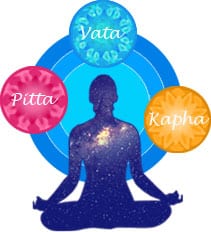Interest in the more subtle Yoga practices related to mental health has expanded. The other side of the Yoga coin, ayurveda (AH-yur-vey-dah), offers 5,000 year old tips on lifestyle and stress management, diet, herbs and cleansing and other complementary healing modalities which can help us to balance symptoms of bipolar disorder. Ayurveda, meaning “the science of life,” and Yoga practices reflect to us how we move through the world, thereby addressing our responsibility for managing our wellness and our root dysfunction triggers.
Basic concepts of ayurveda may seem somewhat complex at the outset but become familiar: The five elements (ether, air, fire, water, earth) combine and segregate into three doshas or energies (vata, pitta and kapha) which make up the principle constitutions of our bodies and mental states, both when well and when imbalanced. Vata (ether + air), pitta (fire + water) and kapha (earth + water) qualities determine physical and mental balance or imbalance. The five elements influence our individual constitution, the seasons and our internal and external environment, including diet. We all express a combination of these five elements and doshas at any given time – sometimes balanced, sometimes imbalanced.
You can find online quizzes to determine your dosha – answering for both your lifelong tendencies (prakruti) and for your acute symptoms (vikruti). There is an online quiz link below.
Ayurveda suggests that like increases like and that a remedy of opposites is beneficial: If youre cold, get warm. If you are hungry, dont starve yourself – eat! If youre stressed out, avoid more stressors.
Vata dosha imbalance (ether & air) rules bipolar disorder, depression and mania. Though there are recognizable elements of pitta in mania (I always say that I am running hot – fire – when I feel hypo-manic) and of kapha in depression (I tend to move really slowly and feel heavy – earth – when depressed), all mental health issues express at least some vata-aggravation.
Vata dosha manifests as movement, expansion, changeability, instability, coldness, subtlety, dryness, roughness and lightness.
Vata imbalances can manifest as insomnia, fear, changing thoughts and feelings, restlessness, weight loss, tremors, hopelessness and over-stimulation. All these symptoms are ruled by the qualities of air and ether: unstable, ungrounded… with one’s head in the clouds… spaced out… jumping out of one’s skin… high as a kite…
Doshas also rule the seasons and certain times of the day. Vata dosha happens to rule late summer and early autumn – which is happening right now! Staying grounded at this time of year is especially important to remedy vata-aggravation and to minimize like increasing like.
Seasonal, ayurvedic, vata-pacifying remedies, appropriate for mental health balance, include things like:
- Following a daily routine, including regular, light exercise, rest and bedtime.
- Avoid stimulants as much as possible, including but not limited to loud music, recreational drugs, caffeine and cigarettes. Stay “grounded” (bring in kapha, earthy qualities).
- Take the time to express gratitude before each meal. Sit for five minutes after every meal to integrate your experience(s).
- Avoid cold, including beverages and ice. Sip warm water.
- Avoid travel and change in general during vata-aggravation. Excitability may affect bipolar symptoms, especially at this time of year. If change cannot be avoided, practice other vata-pacifying techniques to compensate.
- Make sure not to skip meals during autumn to pacify vata dosha. Avoid fasting until the season changes to winter.
- Food pacifies vata and diet should emphasize whole grains, cooked vegetables, mung beans, meats, fresh dairy, nuts and oils in order to ground ones energy. Generally, sweet, sour and salty tastes should be emphasized, as well as the qualities of warm, moist and heavy foods, like stews, soups and Crock pot meals. Use sesame oil or ghee liberally.
- Color therapies and aromatherapies may affect mental states throughout the year. These remedies are subtle but influential. Yellow, green, white, brown, purple and gold are the new black! Rose, frankincense and basil essential oils are balancing for every dosha.
- Meditation, silence, deep breathing, Yoga postures and spending time in nature are balancing remedies for all doshas.
Abhyanga, or ayurvedic self-massage with warmed oil, is especially grounding, soothing and nourishing in autumn and for nourishing the spirit when managing bipolar disorder. Which oils to choose depend on your constitution and current symptoms. Find the links below for more information.
Condensing 5,000 years into a 500 word essay leaves so much information by the wayside! This blog is by no means all-inclusive. Keep in touch with questions and comments, stay curious, and keep your greatest quality of life at the forefront of your mind.
Consider incorporating Yoga and ayurveda practices into your lifestyle for increased wellness!
AUM
See more at:
http://www.ayurvedacollege.com/articles/students/Bipolar%20Disorder#sthash.2Eu4Mp3F.dpuf
http://heymonicab.com/dosha-test/
http://www.yogahealer.com/free-stuff/ – dosha, abhyanga, diet information
https://www.youtube.com/watch?v=_HQLsfZh5js – abhyanga self-massage, link to dosha quiz
www.brookewestyoga.com


